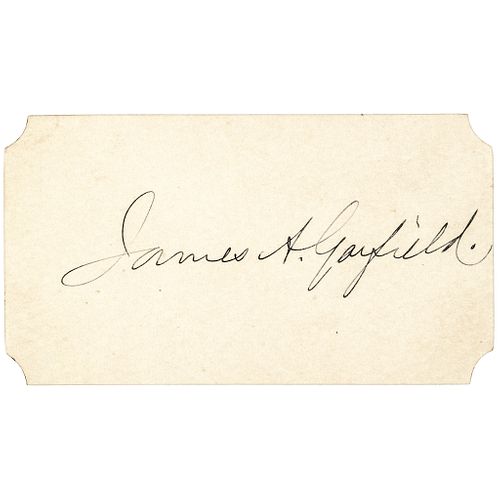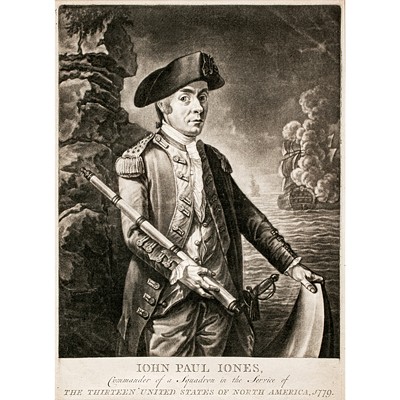Rare JAMES A. + LUCRETIA GARFIELD Signed Cards Dated AS PRESIDENT + FIRST LADY !
Lot 19
Categories
Estimate:
$3,000 - $4,000
Absentee vs Live bid
Two ways to bid:
- Leave a max absentee bid and the platform will bid on your behalf up to your maximum bid during the live auction.
- Bid live during the auction and your bids will be submitted real-time to the auctioneer.
Bid Increments
| Price | Bid Increment |
|---|---|
| $0 | $10 |
| $200 | $20 |
| $300 | $25 |
| $500 | $50 |
| $1,000 | $100 |
| $2,000 | $200 |
| $3,000 | $250 |
| $5,000 | $500 |
| $10,000 | $1,000 |
| $20,000 | $2,000 |
| $30,000 | $2,500 |
| $50,000 | $5,000 |
| $100,000 | $10,000 |
| $200,000 | $20,000 |
| $300,000 | $25,000 |
| $500,000 | $50,000 |
About Auction
By Early American History Auctions
Jan 23, 2021
Set Reminder
2021-01-23 12:00:00
2021-01-23 12:00:00
America/New_York
Bidsquare
Bidsquare : Early American History Auction of Autographs, Americana, Political & Maps
https://www.bidsquare.com/auctions/early-american-history-auctions/early-american-history-auction-of-autographs-americana-political-maps-6311
311 Lots of Rare, Historic Autographs, Americana, Civil War Era, George Washington, Abraham Lincoln, Slavery & Black History, Revolutionary War Era, Colonial America, Federal Period, War of 1812, Colonial Currency, Indian Peace Medals & more... Early American History Auctions auctions@earlyamerican.com
311 Lots of Rare, Historic Autographs, Americana, Civil War Era, George Washington, Abraham Lincoln, Slavery & Black History, Revolutionary War Era, Colonial America, Federal Period, War of 1812, Colonial Currency, Indian Peace Medals & more... Early American History Auctions auctions@earlyamerican.com
- Lot Description
Autographs
President James A. Garfield & First Lady Lucretia Garfield March 15, 1881 Signed Courtesy Autograph Signature Cards
PRESIDENT JAMES ABRAM GARFIELD (November 19,1831-September 19, 1881) & LUCRETIA GARFIELD (First Lady). 20th President of the United States (Presidential term: March 4, 1881 - September 19, 1881) after completing nine Consecutive Terms in the U.S. House of Representatives (1863-1881). Assassinated by Charles Julius Guiteau.
March 15, 1881-Dated, Pair of Matched Courtesy Autograph Signature Cards Signed, "James A. Garfield" As President and "Lucretia R. Garfield" as 1st Lady, Choice Crisp Extremely Fine. Together with the Courtesy Cards original Transmittal Envelope, Stamped and Postally Used, Circular Stamp Dated: "Mar. 15 - 1881 WASHINGTON D. C." The Two Courtesy Cards each measure 2" x 3.5", each signature is well centered and beautifully written by their own hands. Each blank reverse side is dated "Mar. 15, 1881" just a week and a half after James Garfield became acting President, in office from March 4, 1881 to September 19, 1881.
Each of these Matching Cards are very choice in quality, meant for display by their recipient. The Transmittal Envelope measures about 3.5" x 4.5" with its 3 green George Washington U.S. Postage Stamp properly "tied" to the cover, addressed to: Mrs. M. E. Asbury of Springfield, Illinois. The postal cover has some expected circulation from actual use primarily on its reverse.
Garfield's Presidency lasted just 200 days, from March 4, 1881, until his death on September 19, 1881, as a result of being shot by Assassin Charles J. Guiteau on July 2, 1881. Only William Henry Harrison's presidency, of 31 days, was shorter. James A. Garfield was the second of four United States Presidents who were Assassinated. President Garfield's accomplishments included a controversial resurgence of presidential authority in executive appointments; energizing U.S. Naval power; and purging corruption in the Post Office Department. Garfield made notable diplomatic and judiciary appointments, including a U.S. Supreme Court Justice. Garfield also appointed several African-Americans to prominent Federal positions.
As President, Garfield advocated a bimetal monetary system, agricultural technology, an educated electorate, and civil rights for African-Americans. He also proposed substantial civil service reform, eventually passed by Congress in 1883, and it signed into law by his successor, Chester A. Arthur, known as the "Pendleton Civil Service Reform Act".
Exceedingly rare, this matched Pair of "James A. Garfield" & "Lucretia Garfield" Signed Courtesy Cards dated "March 15, 1881" together with their original Postally Used Envelope present an important trio in excellent quality, being Signed as the new President of the United States. (3 items)
James Abram Garfield (November 19, 1831 - September 19, 1881) was the 20th President of the United States, serving from March 4, 1881, until his assassination later that year. Garfield had served nine terms in the House of Representatives, and had been elected to the Senate before his candidacy for the White House, though he declined the Senate seat once he was elected president. He is the only sitting House member to be elected president.
Garfield was raised by his widowed mother in humble circumstances on an Ohio farm. He worked at various jobs, including on a canal boat, in his youth. Beginning at age 17, he attended several Ohio schools, then studied at Williams College in Williamstown, Massachusetts, graduating in 1856. A year later, Garfield entered politics as a Republican. He married Lucretia Rudolph in 1858, and served as a member of the Ohio State Senate (1859-1861).
Garfield opposed Confederate Secession, served as a Major General in the Union Army during the American Civil War, and fought in the battles of Middle Creek, Shiloh, and Chickamauga. He was first elected to Congress in 1862 to represent Ohio's 19th District. Throughout Garfield's extended congressional service after the Civil War, he firmly supported the gold standard and gained a reputation as a skilled orator. Garfield initially agreed with Radical Republican views regarding Reconstruction, but later favored a moderate approach for civil rights enforcement for freedmen.
At the 1880 Republican National Convention, Senator-elect Garfield attended as campaign manager for Secretary of the Treasury John Sherman, and gave the presidential nomination speech for him. When neither Sherman nor his rivals - Ulysses S. Grant and James G. Blaine - could get enough votes to secure the nomination, delegates chose Garfield as a compromise on the 36th ballot. In the 1880 presidential election, Garfield conducted a low-key front porch campaign, and narrowly defeated Democrat Winfield Scott Hancock.
Garfield's accomplishments as president included a resurgence of presidential authority against senatorial courtesy in executive appointments, energizing American naval power, and purging corruption in the Post Office, all during his extremely short time in office. Garfield made notable diplomatic and judiciary appointments, including a U.S. Supreme Court justice.
He enhanced the powers of the presidency when he defied the powerful New York senator Roscoe Conkling by appointing William H. Robertson to the lucrative post of Collector of the Port of New York, starting a fracas that ended with Robertson's confirmation and Conkling's resignation from the Senate. Garfield advocated agricultural technology, an educated electorate, and civil rights for African Americans.
He also proposed substantial civil service reform, eventually passed by Congress in 1883 and signed into law by his successor, Chester A. Arthur, as the Pendleton Civil Service Reform Act.
On July 2, 1881, he was shot at the Baltimore and Potomac Railroad Station in Washington D.C. by Charles J. Guiteau, a lawyer and writer with a grievance. The wound was not immediately fatal for Garfield, but his doctors' uncleaned and unprotected hands are said to have led to infection that caused his death on September 19. Guiteau was convicted of the murder and was executed in June 1882; he tried to name his crime as simple assault by blaming the doctors for Garfield's death. With his term cut short by his death after only 200 days, and much of it spent in ill health trying to recover from the attack, Garfield is little-remembered other than for his assassination. Historians often forgo listing him in rankings of U.S. presidents due to the short length of his presidency.
- Shipping Info
-
Early American provides in-house worldwide shipping. Please contact us directly if you have questions about your specific shipping requirements.
-
- Buyer's Premium



 EUR
EUR CAD
CAD AUD
AUD GBP
GBP MXN
MXN HKD
HKD CNY
CNY MYR
MYR SEK
SEK SGD
SGD CHF
CHF THB
THB
















